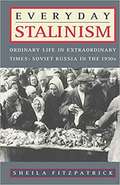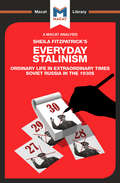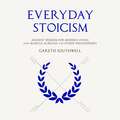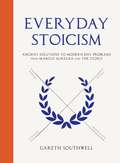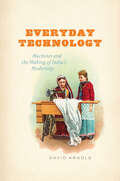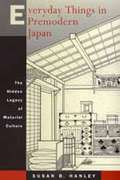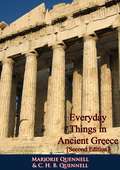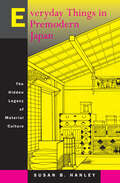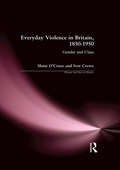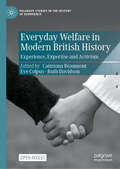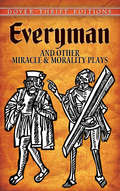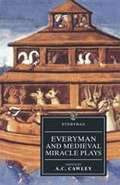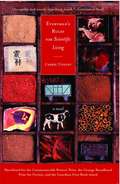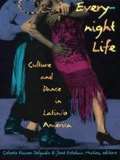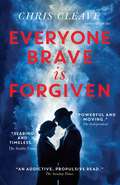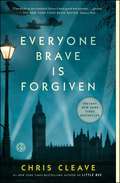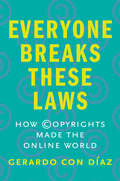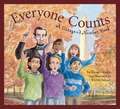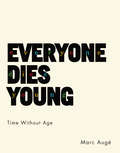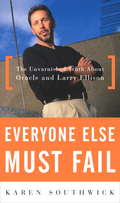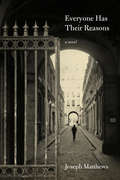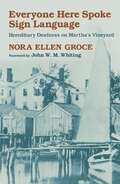- Table View
- List View
Everyday Silence and the Holocaust
by Irene LevinEveryday Silence and the Holocaust examines Irene Levin’s experiences of her family’s unspoken history of the Holocaust and the silence that surrounded their war experiences as non-topics.A central example of what C. Wright Mills considered the core of sociology – the intersection of biography and history – the book covers the process by which the author came to understand that notes found in her mother’s apartment following her death were not unimportant scribbles, but in fact contained elements of her mother’s biographical narrative, recording her parents’ escape from occupied Norway to unoccupied Sweden in late 1942. From the mid-1990s, when society began to open up about the atrocities committed against the Jews, so too did the author find that her mother and the wider Jewish population ceased to be silent about their war experiences and began to talk. Charting the process by which the author traced the family’s broader history, this book explores the use of silence, whether in the family or in society more widely, as a powerful analytic tool and examines how these silences can intertwine. This book provides insight into social processes often viewed through a macro-historical lens by way of analysis of the life of an "ordinary" Jewish woman as a survivor.An engaging, grounded study of the biographical method in sociology and the role played by silence, this book will appeal to readers with an interest in the Holocaust and World War II, as well as in social scientific research methods. It will be of use to both undergraduate and postgraduate scholars in the fields of history, social science, psychology, philosophy, and the history of ideas.The Open Access version of this book, available at http://www.taylorfrancis.com, has been made available under a Creative Commons [Attribution-Non Commercial-No Derivatives (CC-BY-NC-ND)] 4.0 license.
Everyday Stalinism: Ordinary Life In Extraordinary Times: Soviet Russia In The 1930s
by Sheila FitzpatrickHere is a pioneering account of everyday life under Stalin, written by one of our foremost authorities on modern Russian history. Focusing on urban areas in the 1930s, Sheila Fitzpatrick shows that with the adoption of collectivization and the first Five-Year Plan, everyday life was utterly transformed. With the abolition of the market, shortages of food, clothing, and all kinds of consumer goods became endemic. As peasants fled the collectivized villages, major cities were soon in the grip of an acute housing crisis, with families jammed for decades in tiny single rooms in communal apartments, counting living space in square meters. It was a world of privation, overcrowding, endless queues, and broken families, in which the regime's promises of future socialist abundance rang hollowly. We read of a government bureaucracy that often turned everyday life into a nightmare, and of the ways that ordinary citizens tried to circumvent it, primarily by patronage and the ubiquitous system of personal connections known as blat . And we read of the police surveillance that was endemic to this society, and the waves of terror like the Great Purges of 1937, that periodically cast this world into turmoil. Fitzpatrick illuminates the ways that Soviet city-dwellers coped with this world, examining such diverse activities as shopping, traveling, telling jokes, finding an apartment, getting an education, landing a job, cultivating patrons and connections, marrying and raising a family, writing complaints and denunciations, voting, and trying to steer clear of the secret police. Based on extensive research in Soviet archives only recently opened to historians, this superb book illuminates the ways ordinary people tried to live normal lives under extraordinary circumstances.
Everyday Stalinism: Soviet Russia in the 1930s
by Riley Quinn Victor PetrovHow was the Soviet Union like a soup kitchen? In this important and highly revisionist work, historian Sheila Fitzpatrick explains that a reimagining of the Communist state as a provider of goods for the ‘deserving poor’ can be seen as a powerful metaphor for understanding Soviet life as a whole. By positioning the state both as a provider and as a relief agency, Fitzpatrick establishes it as not so much a prison (the metaphor favoured by many of her predecessors), but more the agency that made possible a way of life. Fitzpatrick’s real claim to originality, however, is to look at the relationship between the all-powerful totalitarian government and its own people from both sides – and to demonstrate that the Soviet people were not totally devoid of either agency or resources. Rather, they successfully developed practices that helped them to navigate everyday life at a time of considerable danger and multiple shortages. For many, Fitzpatrick shows, becoming an informer and reporting fellow citizens – even family and friends – to the state was a successful survival strategy. Fitzpatrick's work is noted mainly as an example of the critical thinking skill of reasoning; she marshals evidence and arguments to deliver a highly persuasive revisionist description of everyday life in Soviet time. However, her book has been criticized for the way in which it deals with possible counter-arguments, not least the charge that many of the interviewees on whose experiences she bases much of her analysis were not typical products of the Soviet system.
Everyday Stoicism: Ancient Solutions to Modern Day Problems from Marcus Aurelius and the Stoics
by Gareth SouthwellGrow in wisdom with this practical guide to Stoic philosophy for modern day-to-day lifeDiscover the path to a more contented, fulfilled life through the teachings of Stoic philosophers, from Marcus Aurelius to Epictetus. Learn how to build resilience, foster inner peace, and harness self-control.Stoic philosophy is not an armchair philosophy: it was designed by the ancient Greek and Roman philosophers to be used in day-to-day life, and their teachings offer a host of simple, practical ideas to maximise positivity in our lives.Tackling a key theme each month, from Happiness and Health to Money and Politics, Everyday Stoicism guides you through the calendar year to build a toolkit of simple exercises and practical ideas for how to live these values every day.So, harness the collective wisdom of the ancient Stoic philosophers today and discover the joy of everyday stoicism.
Everyday Stoicism: Ancient Solutions to Modern Day Problems from Marcus Aurelius and the Stoics
by Gareth SouthwellGrow in wisdom with this practical guide to Stoic philosophy for modern day-to-day lifeDiscover the path to a more contented, fulfilled life through the teachings of Stoic philosophers, from Marcus Aurelius to Epictetus. Learn how to build resilience, foster inner peace, and harness self-control.Stoic philosophy is not an armchair philosophy: it was designed by the ancient Greek and Roman philosophers to be used in day-to-day life, and their teachings offer a host of simple, practical ideas to maximise positivity in our lives.Tackling a key theme each month, from Happiness and Health to Money and Politics, Everyday Stoicism guides you through the calendar year to build a toolkit of simple exercises and practical ideas for how to live these values every day.So, harness the collective wisdom of the ancient Stoic philosophers today and discover the joy of everyday stoicism.
Everyday Stoicism: Ancient Solutions to Modern Day Problems from Marcus Aurelius and the Stoics
by Gareth SouthwellGrow in wisdom with this practical guide to Stoic philosophy for modern day-to-day lifeDiscover the path to a more contented, fulfilled life through the teachings of Stoic philosophers, from Marcus Aurelius to Epictetus. Learn how to build resilience, foster inner peace, and harness self-control.Stoic philosophy is not an armchair philosophy: it was designed by the ancient Greek and Roman philosophers to be used in day-to-day life, and their teachings offer a host of simple, practical ideas to maximise positivity in our lives.Tackling a key theme each month, from Happiness and Health to Money and Politics, Everyday Stoicism guides you through the calendar year to build a toolkit of simple exercises and practical ideas for how to live these values every day.So, harness the collective wisdom of the ancient Stoic philosophers today and discover the joy of everyday stoicism.
Everyday Technology: Machines and the Making of India's Modernity
by David ArnoldIn 1909 Mohandas Karamchand Gandhi, on his way back to South Africa from London, wrote his now celebrated tract Hind Swaraj, laying out his vision for the future of India and famously rejecting the technological innovations of Western civilization. Despite his protestations, Western technology endured and helped to make India one of the leading economies in our globalized world. Few would question the dominant role that technology plays in modern life, but to fully understand how India first advanced into technological modernity, argues David Arnold, we must consider the technology of the everyday. Everyday Technology is a pioneering account of how small machines and consumer goods that originated in Europe and North America became objects of everyday use in India in the late nineteenth and early twentieth centuries. Rather than investigate “big” technologies such as railways and irrigation projects, Arnold examines the assimilation and appropriation of bicycles, rice mills, sewing machines, and typewriters in India, and follows their impact on the ways in which people worked and traveled, the clothes they wore, and the kind of food they ate. But the effects of these machines were not limited to the daily rituals of Indian society, and Arnold demonstrates how such small-scale technologies became integral to new ways of thinking about class, race, and gender, as well as about the politics of colonial rule and Indian nationhood. Arnold’s fascinating book offers new perspectives on the globalization of modern technologies and shows us that to truly understand what modernity became, we need to look at the everyday experiences of people in all walks of life, taking stock of how they repurposed small technologies to reinvent their world and themselves.
Everyday Things In Premodern Japan: The Hidden Legacy Of Material Culture
by Susan HanleyJapan was the only non-Western nation to industrialize before 1900 and its leap into the modern era has stimulated vigorous debates among historians and social scientists. In an innovative discussion that posits the importance of physical well-being as a key indicator of living standards, Susan B. Hanley considers daily life in the three centuries leading up to the modern era in Japan. She concludes that people lived much better than has been previously understood—at levels equal or superior to their Western contemporaries. She goes on to illustrate how this high level of physical well-being had important consequences for Japan's ability to industrialize rapidly and for the comparatively smooth transition to a modern, industrial society. <p><p> While others have used income levels to conclude that the Japanese household was relatively poor in those centuries, Hanley examines the material culture—food, sanitation, housing, and transportation. How did ordinary people conserve the limited resources available in this small island country? What foods made up the daily diet and how were they prepared? How were human wastes disposed of? How long did people live? Hanley answers all these questions and more in an accessible style and with frequent comparisons with Western lifestyles. Her methods allow for cross-cultural comparisons between Japan and the West as well as Japan and the rest of Asia. They will be useful to anyone interested in the effects of modernization on daily life.
Everyday Things in Ancient Greece [Second Edition]
by Kathleen Freeman C. H. B. Quennell Marjorie QuennellFirst published in 1954, this is the Second Edition of the single-volume amalgamation of husband-and-wife team Marjorie and Charles Quinnells’ three-volume anthology on Greek antiquity, originally between 1929-1932: Everyday Things in Homeric Greece, Everyday Things in Archaic Greece, and Everyday Things in Classical Greece.Part I tells of the Trojan War and of the heroes who sustained the Greeks in their early struggles, with Homer cited as the main source.Part II deals with the Archaic period (about 560 to 480 B.C.) ending with the great struggle between Greeks and Persians which culminated in the victory of the Greeks at Salamis, as related in the History of Herodotus.Part III begins with the story of how the Greeks went to work after Salamis and built on the well-laid foundations a civilization which ever since has been regarded as Classical and closes with the account in the History of Thucydides of the struggle between Athens and Sparta and the failure of the Athenian Expedition to Sicily.A comprehensive study of Ancient Greek History, revised in this edition by Greek authority Kathleen Freeman.“In this book we have attempted to show some of the beautiful products of these artists, and their use in everyday life. It is our hope that the boys and girls who read it will discover that the Greeks were not a people extremely foreign and remote, who spoke a difficult language, but folk much like themselves, who lived and worked and played in the surroundings and among the objects we have depicted and described.”—Preface
Everyday Things in Premodern Japan: The Hidden Legacy of Material Culture
by Susan B. HanleyJapan was the only non-Western nation to industrialize before 1900 and its leap into the modern era has stimulated vigorous debates among historians and social scientists. In an innovative discussion that posits the importance of physical well-being as a key indicator of living standards, Susan B. Hanley considers daily life in the three centuries leading up to the modern era in Japan. She concludes that people lived much better than has been previously understood—at levels equal or superior to their Western contemporaries. She goes on to illustrate how this high level of physical well-being had important consequences for Japan's ability to industrialize rapidly and for the comparatively smooth transition to a modern, industrial society.While others have used income levels to conclude that the Japanese household was relatively poor in those centuries, Hanley examines the material culture—food, sanitation, housing, and transportation. How did ordinary people conserve the limited resources available in this small island country? What foods made up the daily diet and how were they prepared? How were human wastes disposed of? How long did people live? Hanley answers all these questions and more in an accessible style and with frequent comparisons with Western lifestyles. Her methods allow for cross-cultural comparisons between Japan and the West as well as Japan and the rest of Asia. They will be useful to anyone interested in the effects of modernization on daily life.
Everyday Violence in Britain, 1850-1950: Gender and Class (Women And Men In History)
by Ivor Crewe Shani D'CruzeThe diverse violence of modern Britain is hardly new. The Britain of 1850 to 1950 was similarly afflicted. The book is divided into four parts. 'Getting Hurt' which looks at everyday violence in the home (including a chapter on infanticide). 'Uses and Rejections' two chapters on the use of violence within groups of men and women outside the home (for example, violence within youth gangs, and male violence centred around pubs). 'Going Public' three chapters on how violence was regulated by law and the professional agencies which were set up to deal with it. 'Perceptions and Representations' this final section looks at how violence was written about, using both fiction and non-fiction sources. Throughout the book the recurring themes of gender, class, continuity and change, public/private, and experience, discourses and representations are highlighted.
Everyday Violence in the Irish Civil War
by Gemma ClarkEveryday Violence in the Irish Civil War presents an innovative study of violence perpetrated by and against non-combatants during the Irish Civil War, 1922-3. Drawing from victim accounts of wartime injury as recorded in compensation claims, Dr Gemma Clark sheds new light on hundreds of previously neglected episodes of violence and intimidation - ranging from arson, boycott and animal maiming to assault, murder and sexual violence - that transpired amongst soldiers, civilians and revolutionaries throughout the period of conflict. The author shows us how these micro-level acts, particularly in the counties of Limerick, Tipperary and Waterford, served as an attempt to persecute and purge religious and political minorities and to force redistribution of land. Clark also assesses the international significance of the war, comparing the cruel yet arguably restrained violence that occurred in Ireland with the brutality unleashed in other European conflict zones.
Everyday Welfare in Modern British History: Experience, Expertise and Activism (Palgrave Studies in the History of Experience)
by Eve Colpus Ruth Davidson Caitríona BeaumontThis open access book offers a new approach to understandings of welfare in modern Britain. Foregrounding the agency individuals and groups claimed through experiential expertise, it traces deep connections between personal experience, welfare, and activism across diverse settings in modern Britain. The experiential experts studied in this collection include women, students, children, women who have sex with women, bereaved families, community groups, individuals living in poverty, adults whose status sits outside professional categories, health service users, and people of faith. Chapters trace how these groups have used their experiences to assert an expert witness status and have sought out new spaces to expand the scope, inclusivity, and applicability of welfare services.
Everyman
by AnonymousWestern drama, having all but disappeared during the Dark Ages, reemerged spontaneously in the liturgy and life of the medieval church. Vernacular miracle plays of England's Middle Ages were performed by lay people -- many by trade guilds -- unschooled in church Latin, but familiar with the biblical events upon which the dramas were based. Morality plays provided moral instruction, their principal characters vivid personifications of virtue and vice. The most durable of the morality plays has proven to be Everyman, whose central character, summoned by Death, must face final judgment on the strength of his good deeds. This venerable drama is reprinted here along with three other medieval classics: The Second Shepherds' Play, Noah's Flood, and Hickscorner.
Everyman and Medieval Miracle Plays
by A. C. CawleyThis volume contains the moral play Everyman and a representative collection of medieval biblical pageants. The pageants have been chosen for their intrinsic merit and because together they give a fair idea of the range and content of an English Corpus Christi cycle. They are taken from the cycles of York, Chester, Wakefield, Coventry, and 'N. town', with the addition of an excerpt from the Cornish plays (Appendix I). Most of the original words of the plays are preserved, but for the convenience of the general reader many archaic forms and spellings are modernized or normalized both within the line and in rhyme. Occasionally, however, an archaic form is kept for the sake of the rhyme, and a gloss added if necessary. Original stage directions are given and those in Latin are translated; they are distinguished from editorial directions, which are bracketed. Difficult words and short phrases are glossed in the margin, while longer word-groups needing explanation are paraphrased in footnotes.
Everyman's Rules for Scientific Living
by Carrie TiffanyIn this sensual, witty, and startlingly original first novel, Jean Finnegan searches for her place in a tumultuous world wracked by the Great Depression and the beginning of World War II. Carrie Tiffany captures the frailty and beauty of the human condition and vividly evokes the hope and disappointment of an era. Billowing dust and information, the government "Better Farming Train" slides through the wheat fields and small towns of Australia, bringing advice to the people living on the land. The train is staffed by irresistibly eccentric agricultural and domestic experts, from Sister Crock, the prim head of "women's subjects," to Mr. Ohno, the Japanese chicken specialist, to Robert Pettergree, a scientist with an unusual taste for soil. Amid the swaying cars full of cows, pigs, and wheat, a strange and swift seduction occurs between Robert and Jean. In an atmosphere of heady scientific idealism they settle in the impoverished Mallee farmland with the ambition of transforming the land through science. In luminous prose, Tiffany writes about the challenges of farming, the character of small towns, the stark and terrifying beauty of the Australian landscape, and the fragile relationships among man, science, and nature. Everyman's Rules for Scientific Living is a passionate and heartbreaking novel from an astonishing new writer.
Everynight Life: Culture and Dance in Latin/o America
by José Esteban Muñoz Celeste Fraser DelgadoThe function of dance in Latin/o American culture is the focus of the essays collected in Everynight Life. The contributors interpret how Latin/o culture expresses itself through dance, approaching the material from the varying perspectives of literary, cultural, dance, performance, queer, and feminist studies. Viewing dance as privileged sites of identity formation and cultural resistance in Latin/o America, Everynight Life translates the motion of bodies into speech, and the gestures of dance into a provocative socio-political grammar.This anthology looks at many modes of dance--including salsa, merengue, cumbia, rumba, mambo, tango, samba, and norteño--as models for the interplay of cultural memory and regional conflict. Barbara Browning's essay on capoeira, for instance, demonstrates how dance has been used as a literal form of resistance, while José Piedra explores the meanings conveyed by women of color dancing the rumba. Pieces such as Gustavo Perez Fírmat's "I Came, I Saw, I Conga'd" and Jorge Salessi's "Medics, Crooks, and Tango Queens" illustrate the lively scope of this volume's subject matter.Contributors. Barbara Browning, Celeste Fraser Delgado, Jane C. Desmond, Mayra Santos Febres, Juan Carlos Quintero Herencia, Josh Kun, Ana M. López, José Esteban Muñoz, José Piedra, Gustavo Perez Fírmat, Augusto C. Puleo, David Román, Jorge Salessi, Alberto Sandoval
Everyone Brave Is Forgiven
by Chris CleaveThe breathtaking new novel set during the Blitz by the bestselling and critically acclaimed author of the reader and bookseller favourite, Little Bee.As World War Two begins, Mary--a newly qualified teacher in London, left behind to teach the few children not evacuated--meets Tom, a school official. They quickly fall in love, but this is not a simple love story. . . . Moving from Blitz-torn London to the Siege of Malta, this is an epic story of love, loss, prejudice and incredible courage.From the Hardcover edition.
Everyone Brave is Forgiven
by Chris CleaveThe "insightful, stark, and heartbreaking" (Publishers Weekly, starred review) novel about three lives entangled during World War II from the #1 New York Times bestselling author of Little Bee. "Magnificent and profoundly moving...This dazzling novel of World War II is full of unforgettable characters and the keen emotional insights that moved readers of Chris Cleave's Little Bee." --Shelf Awareness "Real, engaging characters, based loosely on Cleave's own grandparents, come alive on the page. Insightful, stark, and heartbreaking, Cleave's latest novel portrays the irrepressible hopefulness that can arise in the face of catastrophe." --Publishers Weekly (starred review) "Among all the recent fictions about the war, Cleave's miniseries of a novel is a surprising standout, with irresistibly engaging characters." --Kirkus Reviews "Beautifully written, funny, gut-wrenching, and, above all, honest." --The Daily Mail (UK) "Intensely felt...Full of insight and memorably original phrasings." --Booklist "Well crafted and compelling...nostalgic and bittersweet." --Library JournalLondon, 1939. The day war is declared, Mary North leaves finishing school unfinished, goes straight to the War Office, and signs up. Tom Shaw decides to ignore the war--until he learns his roommate Alistair Heath has unexpectedly enlisted. Then the conflict can no longer be avoided. Young, bright, and brave, Mary is certain she'd be a marvelous spy. When she is--bewilderingly--made a teacher, she finds herself defying prejudice to protect the children her country would rather forget. Tom, meanwhile, finds that he will do anything for Mary. And when Mary and Alistair meet, it is love, as well as war, that will test them in ways they could not have imagined, entangling three lives in violence and passion, friendship and deception, inexorably shaping their hopes and dreams. Set in London during the years of 1939-1942, when citizens had slim hope of survival, much less victory; and on the strategic island of Malta, which was daily devastated by the Axis barrage, Everyone Brave is Forgiven features little-known history and a perfect wartime love story inspired by the real-life love letters between Chris Cleave's grandparents. This dazzling novel dares us to understand that, against the great theater of world events, it is the intimate losses, the small battles, the daily human triumphs that change us most.
Everyone Breaks These Laws: How Copyrights Made the Online World
by Gerardo Con DiazCopyright&’s profound impact on the online world as we know it This book is a captivating exploration of the profound impact of American copyright law on our online lives. By telling stories about hope, art, greed, and fear and how they have affected the legal dimensions of creativity and technological change, this book uncovers the hidden forces shaping our digital world. Gerardo Con Díaz examines the strange world of online copyrights from the 1990s to today&’s AI-driven era, showing how our ability to immerse ourselves in digital media depends on the erosion of what it means for people to own their creative works, online and offline. He delves into the often overlooked impact of digital ownership on privacy and self-expression in this fascinating field guide to the complex landscape of online rights.
Everyone Counts: A Citizen's Number Book
by Elissa GrodinHelps young readers better understand and appreciate their roles as citizens of our country. Using numbers, this book takes readers on a tour through America's system of government. Starting with the Constitution to amendments passed thus far (27), to the number of senators in the Senate (100), the parties, processes, people and history of our government are explained.
Everyone Dies Young: Time Without Age (European Perspectives: A Series in Social Thought and Cultural Criticism)
by Marc Augé"We are awash in time, savoring a few moments of it; we project ourselves into it, reinvent it, play with it; we take our time or let it slip away: it is the raw material of our imagination. Age, on the other hand, is the detailed account of the days that pass, the one-way view of the years whose total sum when set forth can stupefy us. Age wedges each of us between a date of birth that, at least in the West, we know for certain and an expiration date that, as a general rule, we would like to defer. Time is a freedom, age a constraint."Marc Augé remembers his beloved childhood cat, who seemed to grow wise with age, though her essential nature remained unchanged. He considers our belief that objects mature, when it is our perception of them that evolves over time. He wonders why public demonstrations of affection between the elderly make the young so uncomfortable and why we torture ourselves with regret at what might have been. Time can be liberating, he finds; it is a resource we can squander or relish. Yet age is a burden, bound by our personal and cultural neuroses. With an ethnologist's understanding of construct and practice, Augé isolates age from the development of consciousness, desire, and representations of the self. In bold, eye-opening strokes, he casts age as a physical marker and treats one's youthful approach to the world as the true measure of life's value.
Everyone Else Must Fail: The Unvarnished Truth About Oracle and Larry Ellison
by Karen SouthwickKaren Southwick’s unauthorized account provides the full story of Larry Ellison’s brilliant, controversial career. Ellison’s drive and fierce ambition created Oracle out of the dust and built it into one of America’s great technology companies, but his unpredictable management style keeps it constantly on the edge of both success and disaster. The hostile bid for PeopleSoft is just the most recent example. With one clever strategic move, Larry Ellison threw much of the business software field into play.The saying “It’s not enough that I succeed, everyone else must fail” has been so often used by or associated with Ellison that most people think it originated with him. It’s actually attributed to Genghis Khan, but it’s a dead-on way to describe not only the way Ellison thinks about competitors but the way he runs Oracle. His weapons are not marauding hordes, but Oracle’s possession of database technology that is crucial for keeping mission-critical information flows working at thousands of organizations, corporations, nonprofits, and government agencies. Inside Oracle, Ellison has time and again systematically purged key operating, sales, and marketing people who got too powerful for his comfort. Most notable was Ray Lane, Oracle’s president for nine years, who was widely credited with bringing order out of the chaos that was Oracle in the early nineties and growing it into a ten billion dollar company. Ellison got rid of the one key person who was building confidence with Wall Street, business partners, and customers that Oracle was no longer flying by the seat of its pants and had its act together. Ellison’s mania for absolute control and his inability to coexist with the very lieutenants who bring much-needed stability to the company have brought Oracle to the brink of collapse before, and may well do it again. Ellison is a throwback to an earlier, much more freewheeling version of capitalism, the kind practiced by the nineteenth-century robber barons who ran their companies as private fiefdoms. Larry Ellison is one of the most intriguing and dominant leaders of a major twenty-first-century corporation, and Everyone Else Must Fail raises the question of whether Oracle’s products and the reliance placed in them by so many are too important to be subject to the whims of one man. While giving credit to Ellison’s brilliance and devotion, the book sounds a warning about an ingenious man’s tendency to be his own company’s worst enemy.
Everyone Has Their Reasons
by Joseph MatthewsAt a time when the issues of identity, immigration, and class remain both universally important and enormously controversial, this book is an accessible and captivating tale of one boy's historically famous experience in the extraordinary setting of roiling pre-WWII Paris. On November 7, 1938, a small, slight 17-year-old Polish-German Jew named Herschel Grynszpan entered the German embassy in Paris and shot dead a consular official. Three days later, in supposed response, Jews across Germany were beaten, imprisoned, and killed, their homes, shops, and synagogues smashed and burned—Kristallnacht, the Night of Broken Glass. Based on the historical record and told through his "letters" from German prisons, this novel begins in 1936, when 15-year-old Herschel flees Germany, and continues through his show trial, in which the Nazis sought to demonstrate through his actions that Jews had provoked the war. But Herschel throws a last-minute wrench in the plans, bringing the Nazi propaganda machine to a grinding halt and provoking Hitler to postpone the trial and personally give an order regarding Herschel's fate.
Everyone Here Spoke Sign Language: Hereditary Deafness on Martha's Vineyard
by Nora E. Groce<P>From the seventeenth century to the early years of the twentieth, the population of Martha's Vineyard manifested an extremely high rate of profound hereditary deafness. <P>In stark contrast to the experience of most deaf people in our own society, the Vineyarders who were born deaf were so thoroughly integrated into the daily life of the community that they were not seen-- and did not see themselves-- as handicapped or as a group apart. Deaf people were included in all aspects of life, such as town politics, jobs, church affairs, and social life. <P>How was this possible? On the Vineyard, hearing and deaf islanders alike grew up speaking sign language. This unique sociolinguistic adaptation meant that the usual barriers to communication between the hearing and the deaf, which so isolate many deaf people today, did not exist.

